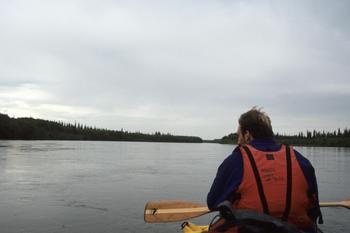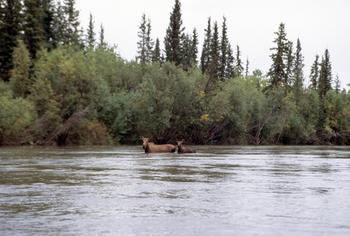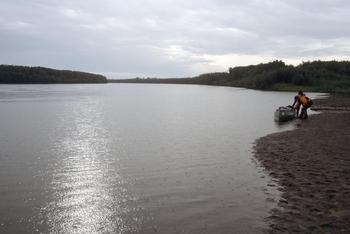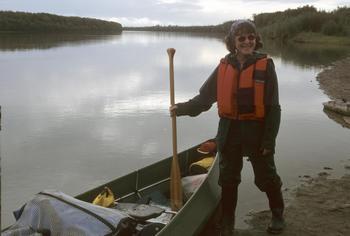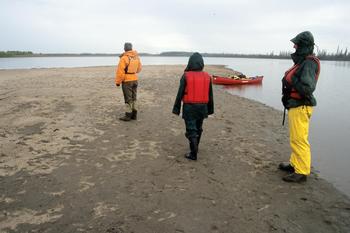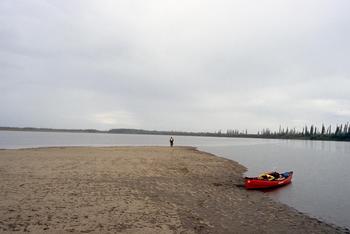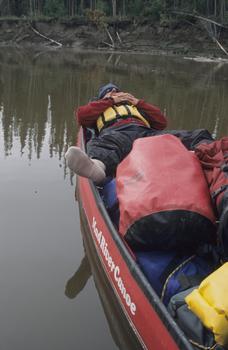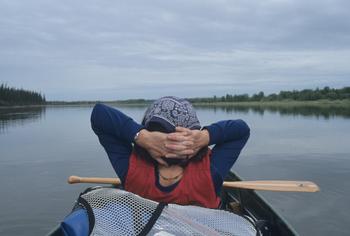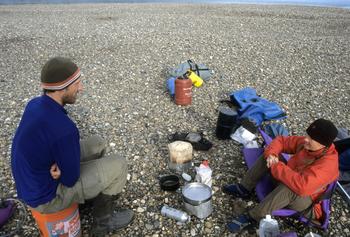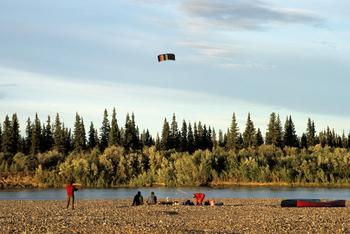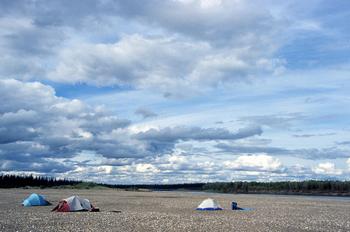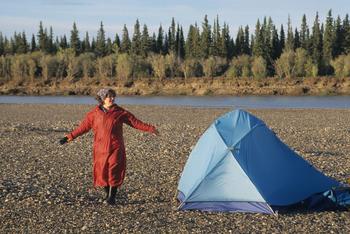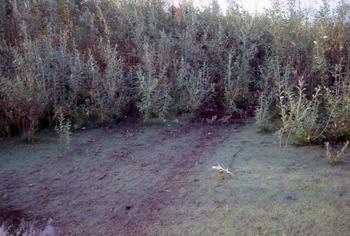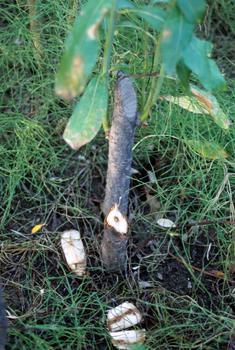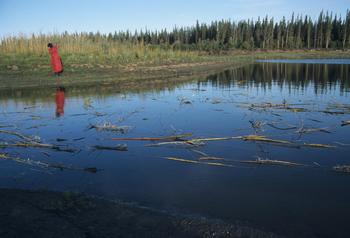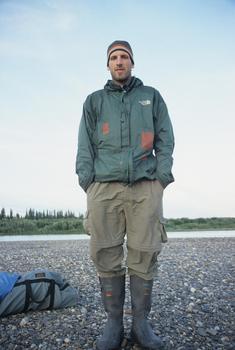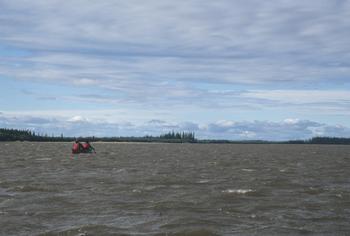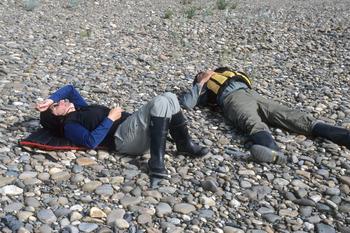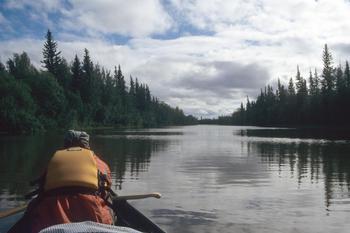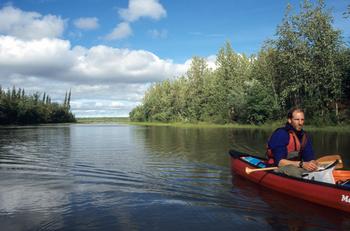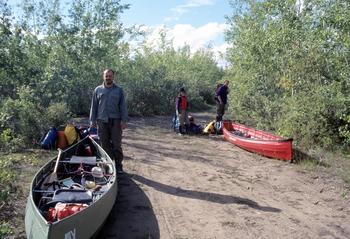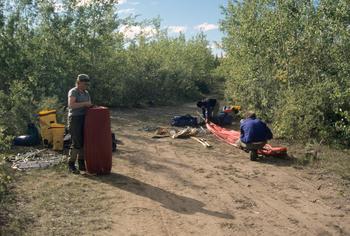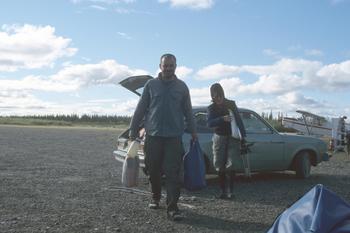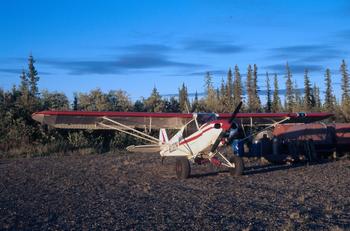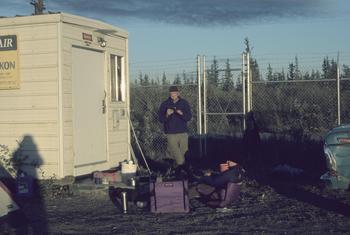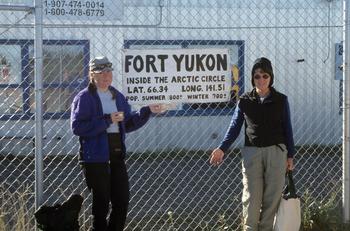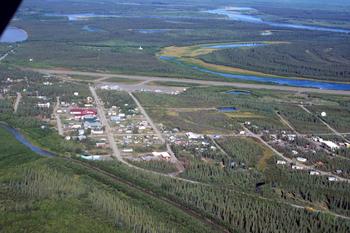8/16/03 - Confluence
6am start. research station. rain. cow and calf. confluence. stern of Sean’s boat. float. gravel bar. Tommy Edison.
This is one of the first days where we paddle in the rain, a light drizzle. We pass a research station to the right. Further, the river gets very wide. A bend to the left and there is the Porcupine river. We stop at the sandbar to savor this historic moment.
Travel down the Porcupine is easy. Current is strong and we just float round multiple bends.
|
|
|
Tommy Edison comes over just as we are starting desert. M tells us to put the whiskey away since alcholism is a problem in many of the communities and Tommy seems to be staggering. In the conversation Tommy mentions that he give it up years ago. That must have been hard to do, living in a town where everyone else is still drinking. Tommy says that is why he is out here: "To get away from the drinking. Few other natives come out this way. Most like to sit in the village where they can drink and watch TV."
Tommy talks a lot about moose. There is a cow and a calf living on this section of river. He likes having them here because they may attract a bull later in the season. The bulls are at the lakes near by. In a couple weeks when the leaves are turning yellow they'll come down to the river. I guess they are in rut then, looking for some women.
Tommy describes two techniques he uses for getting a moose. He can rub a moose shoulder blade against some brush. This makes a sound like another moose rubbing their antlers on the brush and other bulls near by will come running to challenge them. The other is to catch one swimming the river. He'll jump in his boat and drive up to the crossing. When the moose steps out on the bank bang!, Tommy drops him.
In the winter he can run them down in his snow go, which travels at 60 mph.
He also has a tip for hunting ducks and geese. Wait until late fall, just before the migrate. They are cold and don't like to fly. Then you can drive right up to them and shoot them.
Tommy has some conflicting philosophy. He likes being out here because the water is clear and the air is clear, and there are no chemicals. But he smokes and he disposes of his garbage by "sinking it in the river". His garbage is probably very different from my home garbage: moose bones, duck bones, food cans, half used tin of oil.
8/17/03 - Final paddling day
1:30 I get up to pee. Sun below the northern horizon, fait red glow. Moon to the SE. Some red star to the west. Silvery light across the gravel. It was something that you have to be there to appreciate.
6:45 Up. Walk to north side of island with Billie to look at beaver signs. There are good tracks into the forest where the beavers cut willow saplings. In a small lagoon there is a collection of saplings. Some seem to have been there long enough that new sprouts are growing out the side toward the sky.
|
|
|
Today is windy. Thoughs of a relaxing float into Ft Yukon are gone,we have to fight for every boat length.
|
|
|
7:00 pm. Kirk lands. he sits and talks to us for a while. I learn that he has a lot more experience than flying bush planes in Alaska. He's flown in northern Canada and Greenland and in Antarctica on a variety of craft, some very specialized for supporting military research which required landing on pack ice. Knowing that he has all this experience I feel retroactively safer.
I also learn:
- His plane is a Cessna 185 modified in several was for bush flight and short runway landing and take off.
- His plane may cost $150,000 and that the price of 185's have gone up in general. With the rising cost of planes the cost of insurance has also gone up.
- Interestingly the insurance is only concerned about the plane, not liability. He says that the insurance companies figure that most bush plane crashes occur during landing or take off. At these times the plane is not moving very fast, only 40 mph or so - not much energy in that - and no one is likely to get very hurt. I guess this means that you really could land one of these just about anywhere, provided you were not overly concerned about taking off again.
- The small plane parked near by is a piper cub. About every third guy in Alaska owns a cub. They are skin on frame - if I tap the plane it resonates like a drum - fly very slow (80mph?), but still sell for $80,000. There is a sign in this plane saying "max cargo 50lbs". I do the math and figure out that if you kill a 1,500 lb moose it will take 30 flights to haul it out. That's got to be some expensive moose meat.
- Kirk says that is just the rated capacity and that it really will carry more. This cub is owned by guide who uses it to shuttle hunters around the bush. One thing cubs are very good at is short runway landing. The cargo capacity labeled is home made and could just be telling the passenger to not put more than 50lbs in their backpack. Kirk, on the other hand, operates his 185 under rated capacity, which is necessary to get it to do what he wants. Land and take off on short gravel bars in the bush, I guess.
- Planes in Antarctic regularly fly at 1.5 times rated capacity. The cold air is thick and provides extra efficiency from the engine and extra lift from the wings. It does not provide extra structural strength so some governmental agencies have baulked at endorsing what is common practice because it violates official practice.
- The research station we passed is involved in counting salmon. The biologist radio tagged 1,000 salmon at the mouth of the Yukon and have antenna set up at various points to see where they end up. Unfortunately, many don't show up anywhere and the biologists don't have a way to account for what happened to them. Some times they hire Kirk to fly around with an antenna on this plane looking for signals from lost fish.
It gets cold in the evening and we are soon bundled in layers of clothing. Through the night the airport beacon flashes blue and orange against my tent.
8/18/03 - Fairbanks.
I get up at 5:30 to drink water and journal. By 6:30 my fingers are numb and I’ve twice been warned that my palm battery is dying. Back to the tent and sleep until 8 when Kirk shows up.
Kirk's flying up to the Kongacut to shuttle some hikers to Barter Island where they can catch a commercial flight. This seems like a long way for him to go. If the hikers are paying for all the air time that is an expensive flight. Possible Kirk is working it into other shuttling and splitting the cost. I talked to a pilot in Perdough bay who would have been a lot closer, thus cheaper. But maybe Kirk is more reliable?
The guide who owns the Cub shows up at 9. Very friendly. He and his wife like Seattle. I've heard that from several people. The women who owns the restaurant we have lunch in also loves Seattle, especially Bellevue and Kirkland (which she calls the most beautiful place she knows).
The guide volunteers to tell Wright Air that we are looking for a flight out today. Any one of us could have walked over there and told them, and we would have eventually, but he steps in and does it for us. Things get done very easily up here.
Well, usually. Another Cub lands. The pilot is flying up to the Kongacut solo to spend 5 days hunting and wants to fill up before heading out. He was to wait for Kirk's wife Jill to bring the key down. It is not until an hour later, as we are taxing out, that I see her crossing the airfield pushing their son in a stroller. So things are not always fast but very personal.
It is exciting to take off in another bush flight. Taxi, acceleration, smooth flight. Bank and look down on the town. Higher up we see the rivers and the flats. But then there is a long middle part of the flight where we are in a noisy can peering down at the ground. This would be far more interesting if I was flying, but give it a year and that would be about like driving. Earlier on the trip Marie was asking us if there was anything that we liked doing but would not like if it were a job. I don't fly, but would like to. But if I took it as a job I think it would get routine after not too long. Even the bush flying. Kirk probably spends 3 to 5 hours in his plane by himself. Noisy box, hands on controls, not much happening.
|
|
After landing in Fairbanks we are docked $175 for extra baggage. Maybe we should not have saved all those plastic bags for reuse. I'm glad I disposed of my boots in Fort Yukon.
Now we are standing outside Wrights with an unmanageable pile of gear. Fortunately a double cab pick up taxi shows up and can take us all to the airport for $20. There we rent a Subaru and get our stuff to a super 8 in 2 loads. Marie swears that she is going to pick through her gear to figure out what she used and what she did not so she can take less on future trips. Here's a short list off the top of my head:
- Tripod
- Neoprene booties
- Hiking boots
- Bear barrel
Dang. I was hoping that I could pare down more, but I really used most everything else.
